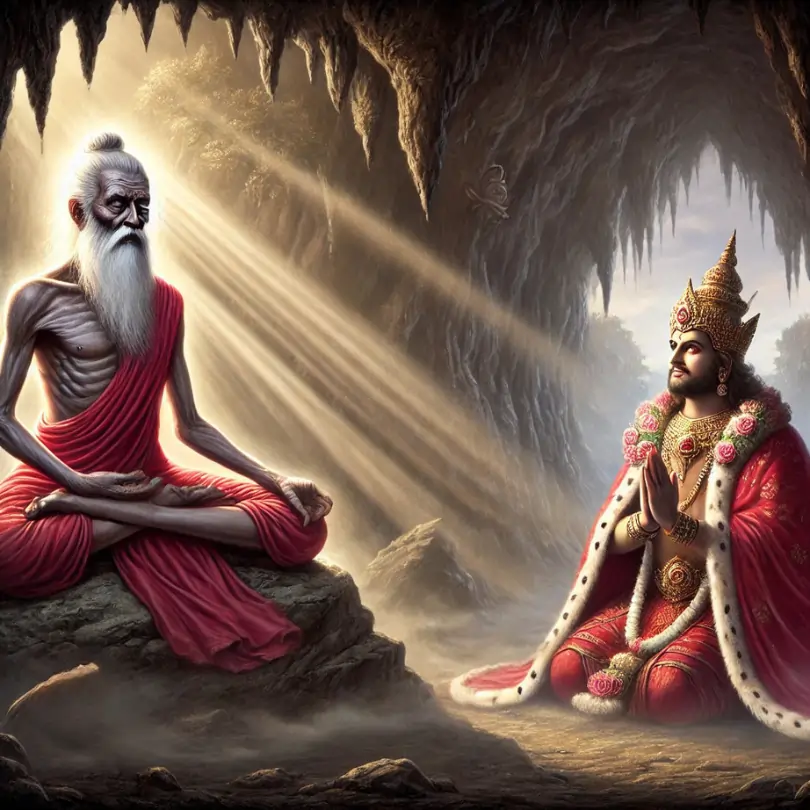A Corrupted Kingdom
In the time of a King named Gunakamadeva, the kingdom descended into moral decay. The King, along with his subjects, succumbed to indulgence in worldly pleasures.
Note: King Gunakamadeva referred in Swayambhu Purana should be different from the Thakuri King Gunakamadeva of Nepal Valley from the 9th century CE, as this tale was told by Shakyamuni Buddha to Maitreya in the 5th century BCE.
The King had abandoned his devotion to the sacred Triad of Buddha, Dharma, and Sangha, favoring instead the company of beautiful women. His ministers, too, immersed themselves in vice and corruption. Displeased with their actions, the heavenly deities sent a devastating drought and famine to punish the kingdom.
The Sage in Samadhi
Overwhelmed by the suffering of his people, King Gunakamadeva repented and journeyed to the sacred site of Swayambhu Dharmadhatu and the temple of Shantipur. Within the temple resided Shantikar Vajracharya, a great Siddha who had mastered deep Samadhi and Pranayama, allowing him to live without breathing. The sage was known for his knowledge of potent mantras and dharanis, including the Mahamegha Nirnada Vijrimbhi Suraketu Dharani (महामेघ निःनाद विजृम्भी सुरकेतु), capable of invoking rainfall.
Realizing the desperation of the people, Shantikar Vajracharya emerged from his meditative state and granted the King an audience. The King, showing great reverence, pleaded for his help in ending the drought. The sage advised the King and his subjects to abandon their wicked ways, embark on pilgrimages to holy sites, and embrace the Dharma.
A Kingdom’s Transformation
Heeding the sage’s instructions, the King and his people began to reform. Their collective efforts brought some improvement to the oppressive atmosphere, yet rainfall remained elusive. Shantikar Vajracharya determined that a Naga Sadhana ritual was essential to summon rain.
The Siddha called upon all the Nagarajas (Serpient Kings) of the Valley to participate in the ritual. While most responded, Karkotaka Nagaraja, the former King of Nagavasahrada, residing in a palace of jewels at Taudaha, refused to come.
A Reluctant Nagaraja
Through meditation, Shantikar Vajracharya discerned that Nagaraja Karkotaka’s reluctance stemmed from embarrassment. The sage requested King Gunakamadeva to personally invite the Nagaraja with prayers and to use force if necessary.
The King approached Karkotaka three times with heartfelt prayers, but the Nagaraja remained obstinate. Finally, invoking the power bestowed by the sage, the King seized Karkotaka by the neck and dragged him to Shantipur.
The Ritual and the Pact
At Shantipur, Shantikar Vajracharya, alongside the King, offered prayers and respect to the assembled Nagarajas. The sage addressed them, saying, “O Nagarajas, I have summoned and worshipped you for the welfare of all beings. I beseech you to grant adequate rainfall to the world.”
Moved by the sage’s sincerity, the Nagarajas pledged to bring rainfall. They also agreed that in times of future drought or famine, their images could be established in a mandala drawn on cloth and ritually worshipped to invoke rain.
To safeguard this knowledge, Shantikar Vajracharya preserved the sacred mandala in Nagapur at Swayambhu, ensuring it could serve as a means to summon rain in the future.
Rainfall and Renewal
As the Nagarajas departed to their abodes, dark clouds gathered in the sky, and rain showered upon the parched earth. The kingdom’s drought was relieved, and the people rejoiced in their newfound prosperity.
King Gunakamadeva, having fulfilled his purpose and grown old, retired to a life of meditation. Shantikar Vajracharya also returned to Shantipur temple to resume his deep Samadhi. The sacred Naga Mandala was enshrined in Nagapur, and the original text of the Mahamegha Mahayana Sutra was preserved within the Shantipur temple, both believed to exist to this day.
Swayambhu Purana – Table of Contents
« Chapter 9: Glory of Shantikar Vajracharya
Chapter 11: Glory of Swayambhu »

